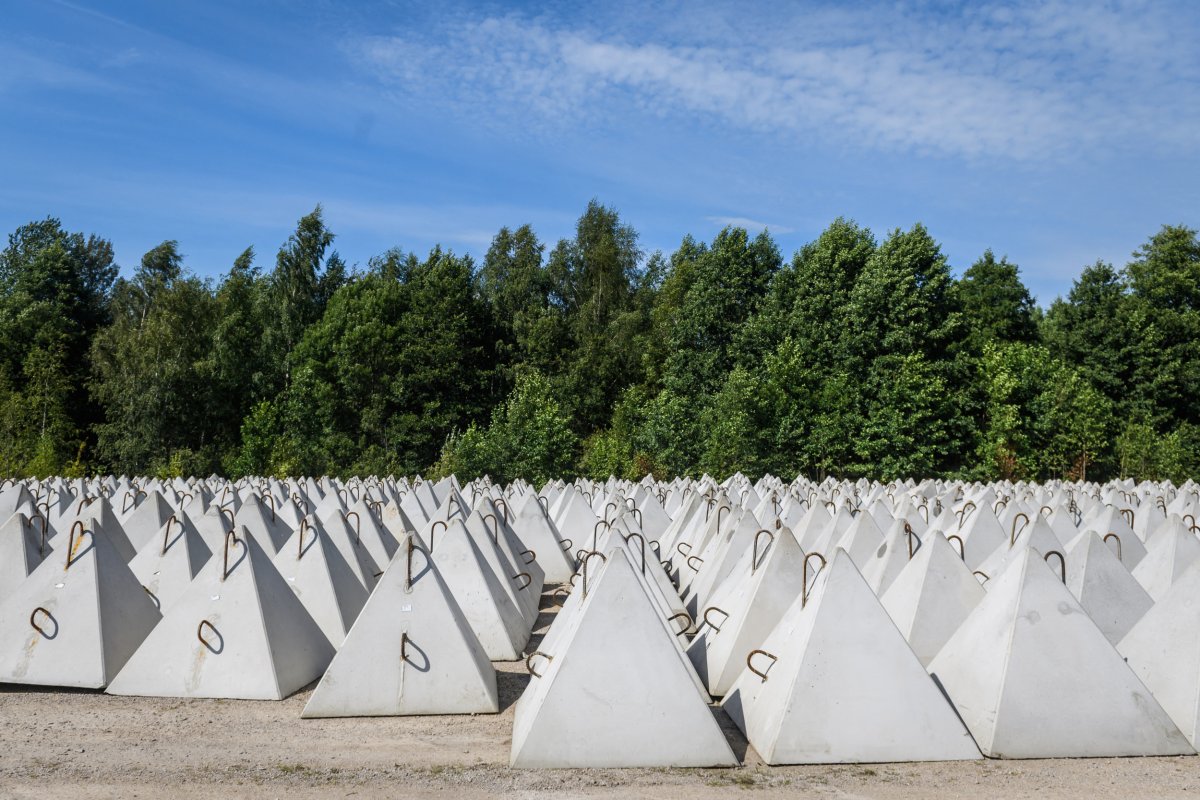Lithuania has installed anti-tank concrete pyramids by the Russian enclave it borders in the latest measure taken by a NATO country on the alliance’s eastern flank to tackle the security risk posed by Moscow.
Lithuanian defense minister Laurynas Kasciunas posted an image of the so-called “dragon teeth” next to a message on X. He said Vilnius had “fortified another bridge over the Nemunas River on the route from…Kaliningrad,” whose location would make it a front line in any conflict between Moscow and NATO.
“Fortifications are progressing as planned, with some bridges set to be demolished,” he added in Wednesday’s post. “Fortifications will be supported by firepower, in case it’s needed, to stop and destroy the enemy.”
Russia was not mentioned but the context was clear with European security upended by Vladimir Putin‘s full-scale invasion of Ukraine, putting NATO’s eastern flank on high alert.

A photo-illustration shows NATO flags, along with troops and weaponry. NATO member states are massively beefing up their defenses on the alliance’s eastern flank.
Photo Illustration by Newsweek/Getty Images
The Baltic States “are determined to ensure what happened to Ukraine will not happen to them,” Roger Hilton, defense research fellow at the Slovakia-based think tank GLOBSEC told Newsweek.
Lithuania’s neighbor Latvia announced on October 2 it had deployed mobile combat groups equipped with air defense missiles in Latgale near the Russian-Latvian border. It has also set up specialized radars along the border to detect drones.
This followed a Russian Shahed-type UAV (unmanned aerial vehicle) landing in Latvia’s Rezekne municipality on September 7. A spate of Moscow’s drones landing on alliance territory has spurred the Bucharest 9 bloc to call for a “collective answer” from the alliance.
There is no evidence that NATO territory was being deliberately targeted by Moscow but independent Russian outlet Verstka reported in September that debris from missiles and drones had landed on 20 occasions in NATO members, with 13 of the incidents in Romania, often close to Ukrainian Danube River ports that are frequent Russian targets.
The Baltic Defense Line was announced in January by the three former Soviet republics of Estonia, Latvia and Lithuania. In May, Poland announced a similar $2.6 billion “Eastern Shield” project to strengthen its borders with Kaliningrad and Belarus, which is Russia’s closest ally.
Warsaw said construction would start by the end of the year and the project of fortifications, surveillance, reconnaissance and anti-drone systems would be completed by 2028.

Dragon’s teeth fortifications, pyramidal anti-tank obstacles, are seen during a press tour to present military reinforcement measures in Karsava, near Latvia’s border with Russia, on August 16, 2024. Poland and the Baltic States, which all border Russia, are fortifying their eastern frontiers.
GINTS IVUSKANS/Getty Images
“The Baltic Defense Line with anti-mobility and anti-tank installations is not only a preemptive measure to deter Russia, but also a policy choice to ensure that should NATO be activated militarily, its role will be to defend territory, not liberate it,” Hilton said.
“The threat posed by Russia to the Baltics is unique not only from a material and geographical standpoint, but also due to the weaponization potential of ethnic Russian minorities inside the countries,” added Hilton.
“Moscow has long seen the strategic value in investing in inflaming societal tensions between Russian native speakers and [national governments],” said Hilton. “Despite the growing chorus, an alliance wide consensus of the Russian threat remains a work in progress and a continual exercise for new (NATO) secretary-general (Mark) Rutte to advance.”
In June, Warsaw and the Baltic States called on the European Union to build a 700-kilometer (430-mile) wall along their borders with Russia and Belarus, releasing a map of the area of the proposed construction. Poland also joined with Greece in asking the EU to set up Europe-wide air defense system akin to Israel’s Iron Dome.
Meanwhile, NATO members have accused Russia of conducting hybrid attacks such as covert operations like disinformation and cyberattacks.
Finland, which joined the alliance last year, closed its border with Russia which it claimed had pushed migrants toward its frontiers. Moscow has also been accused of GPS jamming in the Baltic region, which has led to warnings about the threats posed to air traffic control.
On Thursday, Rutte met with Ukrainian President Volodymr Zelensky, alongside U.K. Prime Minister Keir Starmer, to discuss increasing the alliance’s support for Kyiv against Russian aggression.
Newsweek has contacted the Russian foreign ministry for comment.





